Vol. 150, No. 9 — May 4, 2016
Registration
SOR/2016-75 April 15, 2016
EXPLOSIVES ACT
Regulations Amending the Explosives Regulations, 2013
P.C. 2016-228 April 15, 2016
His Excellency the Governor General in Council, on the recommendation of the Minister of Natural Resources, pursuant to section 5 (see footnote a) of the Explosives Act (see footnote b), makes the annexed Regulations Amending the Explosives Regulations, 2013.
Regulations Amending the Explosives Regulations, 2013
Amendments
1 Subsection 6(3) of the Explosives Regulations, 2013 (see footnote 1) is amended by adding the following in alphabetical order:
product name means the trade name or part number of an explosive, or both in the case of an explosive that has both a trade name and a part number. (nom de produit)
2 Paragraph 28(b) of the Regulations is replaced by the following:
- (b) a short description of the explosive and its properties, as well as its *product name;
3 (1) The portion of section 29 of the Regulations before paragraph (a) is replaced by the following:
Application for specified period
29 An applicant for an authorization for a specified period, if the explosive is for use other than at a tour or international competition involving fireworks, must complete, sign and send to the Chief Inspector of Explosives the application form provided by the Department of Natural Resources. The application must include the following information:
(2) Paragraph 29(c) of the Regulations is replaced by the following:
- (c) a short description of the explosive and its properties, as well as its *product name;
4 The portion of section 30 of the Regulations before paragraph (a) is replaced by the following:
Application for specified period — tour or competition
30 An applicant for an authorization for a specified period, if the explosive is for use at a tour or international competition involving fireworks, must complete, sign and send to the Chief Inspector of Explosives the application form provided by the Department of Natural Resources. The application must include the following information:
5 (1) Paragraph 45(c) of the Regulations is replaced by the following:
- (c) in the case of *small arms cartridges, the cartridges do not include a tracer, incendiary or similar military component or device; and
(2) The portion of item 1 of the table to section 45 of the Regulations in column 1 is replaced by the following:
- 1 Model rocket motors that have a maximum total impulse of 80 newton-seconds (NFPA alpha designations A to E, as indicated on the motor or its packaging)
6 Paragraph 46(1)(f) of the Regulations is replaced by the following:
- (f) the name of the person who obtained the authorization of each explosive;
7 (1) Paragraph 47(2)(b) of the Regulations is replaced by the following:
- (b) either the date of its *manufacture and the shift during which it was manufactured, if any, or its lot number;
(2) Paragraphs 47(5)(a) and (b) of the Regulations are replaced by the following:
- (a) the words “Ammunition/Munitions”, “Explosives/Explosifs”, “Fireworks/Pièces pyrotechniques”, “Pyrotechnics/Pièces pyrotechniques” or “Rocket Motors/Moteurs de fusée”, as the case may be, on the outer packaging and any inner packaging;
- (b) the *product name of the explosive and the name and address of the person who obtained its authorization, on the outer packaging;
- (c) in the case of a type F explosive, whether it is type F.1, F.2, F.3 or F.4, on the outer packaging; and
- (d) in the case of a type S explosive, whether it is type S.1 or S.2, on the outer packaging.
(3) Section 47 of the Regulations is amended by adding the following after subsection (9):
Exception
(10) Subsections (7) to (9) do not apply to a holder that reports the importation of explosives by electronic means in accordance with section 4 of the Reporting of Imported Goods Regulations.
8 Paragraph 48(e) of the Regulations is replaced by the following:
- (e) the name of the person who obtained the authorization of each explosive;
9 (1) Paragraphs 49(1)(a) and (b) of the Regulations are replaced by the following:
- (a) the words “Ammunition/Munitions”, “Explosives/Explosifs”, “Fireworks/Pièces pyrotechniques”, “Pyrotechnics/Pièces pyrotechniques” or “Rocket Motors/Moteurs de fusée”, as the case may be, on the outer packaging and any inner packaging;
- (b) the *product name of the explosive and the name and address of the person who obtained its authorization, on the outer packaging;
(2) Section 49 of the Regulations is amended by adding the following after subsection (4):
Exception
(5) Subsections (2) to (4) do not apply to a holder that reports the importation of explosives by electronic means in accordance with section 4 of the Reporting of Imported Goods Regulations.
10 (1) Paragraph 74(1)(b) of the Regulations is replaced by the following:
- (b) either the date of its *manufacture and the shift during which it was manufactured, if any, or its lot number;
(2) Paragraphs 74(3)(a) and (b) of the Regulations are replaced by the following:
- (a) the words “Ammunition/Munitions”, “Explosives/Explosifs”, “Fireworks/Pièces pyrotechniques”, “Pyrotechnics/Pièces pyrotechniques” or “Rocket Motors/Moteurs de fusée”, as the case may be, on the outer packaging and any inner packaging;
- (b) the *product name of the explosive and the name and address of the person who obtained its authorization, on the outer packaging;
- (c) in the case of a type F explosive, whether it is type F.1, F.2, F.3 or F.4, on the outer packaging; and
- (d) in the case of a type S explosive, whether it is type S.1 or S.2, on the outer packaging.
11 The definition division 2 factory licence in section 106 of the Regulations is replaced by the following:
division 2 factory licence means a licence that is issued by the Minister under paragraph 7(1)(a) of the Explosives Act authorizing a manufacturing activity referred to in section 53 at a workplace. (licence de fabrique de la section 2)
12 Paragraphs 117(2)(a) and (b) of the Regulations are replaced by the following:
- (a) the words “Ammunition/Munitions”, “Explosives/Explosifs”, “Fireworks/Pièces pyrotechniques”, “Pyrotechnics/Pièces pyrotechniques” or “Reloaded Cartridges/Cartouches rechargées”, as the case may be, on the outer packaging and any inner packaging;
- (b) the *product name of the explosive and the name and address of the person who obtained its authorization, on the outer packaging;
- (c) in the case of a type F explosive, whether it is type F.1, F.2, F.3 or F.4, on the outer packaging; and
- (d) in the case of a type S explosive, whether it is type S.1 or S.2, on the outer packaging.
13 The definitions user magazine licence and user magazine zone licence in section 144 of the Regulations are replaced by the following:
user magazine licence means a licence that is issued under paragraph 7(1)(a) of the Explosives Act and authorizes the storage of explosives by a person who has acquired them for use or conveyance. (licence de poudriére (utilisateur))
user magazine zone licence means a licence that is issued under paragraph 7(1)(a) of the Explosives Act and authorizes the storage of type E or I explosives by a person who has acquired them for use. It also authorizes the holder to move the storage of explosives from one site to another. (licence de poudrière (utilisateur-zone))
14 (1) Subsection 153(1) of the Regulations is replaced by the following:
Unlocked magazine
153 (1) A magazine must be *attended in person when it is unlocked.
(2) Paragraphs 153(2)(d) and (e) of the Regulations are replaced by the following:
- (d) each key must be kept in a locked and secure location when it is not in the possession of a person named in the plan; and
- (e) in the case of an *industrial explosive or a type D explosive, the lock on the magazine must be of a type for which keys can be obtained only from the lock’s manufacturer or a certified locksmith designated by the manufacturer.
15 Subsection 158(2) of the Regulations is replaced by the following:
Attendance of explosives
(2) Any explosives that are not put into another magazine must be *attended in person.
16 (1) The portion of subsection 162(1) of the Regulations before paragraph (a) is replaced by the following:
Notice of change of site
162 (1) When the storage of explosives that is authorized by a user magazine zone licence is moved to a new site, within 24 hours after the move the holder of the licence must complete, sign and send a notice of change of site, in the form provided by the Department of Natural Resources, to the Minister, to the police force in the locality of the previous site and to the police force in the locality of the new site. The notice must be dated and include the following information:
(2) Paragraph 162(1)(d) of the Regulations is replaced by the following:
- (d) the date on which the storage of explosives began at the new site;
(3) Paragraphs 162(1)(e) to (g) of the French version of the Regulations are replaced by the following:
- e) les coordonnées géographiques de l’ancien site et du nouveau site;
- f) les instructions routières sur la façon de se rendre au nouveau site;
- g) les dispositifs de sécurité et de sûreté sur le nouveau site (par exemple, panneaux, systèmes d’alarme, barrières, clôtures et merlons);
(4) The portion of paragraph 162(1)(h) of the Regulations before subparagraph (ii) is replaced by the following:
- (h) a list of the magazines to be used at the new site that sets out
- (i) in the case of a magazine that has been moved, its number, letter or distinctive name as shown on the previous site plan,
17 Section 163 of the French version of the Regulations is replaced by the following:
Copie de la licence et de l’avis
163 Le titulaire d’une licence de poudrière (utilisateur-zone) veille à ce qu’une copie de la licence et une copie de l’avis de changement de site soient affichées dans chaque poudrière.
18 (1) Paragraph 170(1)(b) of the Regulations is replaced by the following:
- (b) for each UN number, the quantity of explosive that was acquired, *manufactured, imported, exported, used, sold, lost, stolen or destroyed during the calendar year; and
(2) Section 170 of the Regulations is amended by adding the following after subsection (2):
Exception
(3) Subsections (1) and (2) do not apply to a holder that reports the importation of explosives by electronic means in accordance with section 4 of the Reporting of Imported Goods Regulations.
19 Subsection 176(1) of the Regulations is replaced by the following:
Approval letter or equivalent document
176 (1) An individual who applies for a licence, permit or certificate or for the renewal of one must include with their application proof that they have an approval letter or equivalent document.
20 Subsection 177(1) of the Regulations is replaced by the following:
Issuance of document
177 (1) If the applicant’s criminal record check does not reveal any of the circumstances set out in subsection (2) or the applicant has an equivalent document, the Minister may issue or renew the licence, permit or certificate.
21 (1) Subparagraphs 190(1)(c)(i) and (ii) of the Regulations are replaced by the following:
- (i) UN 0012, CARTRIDGES, SMALL ARMS,
- (ii) UN 0014, CARTRIDGES, SMALL ARMS, BLANK or CARTRIDGES FOR TOOLS, BLANK,
(2) Subparagraph 190(1)(c)(iv) of the Regulations is replaced by the following:
- (iv) UN 0055, CASES, CARTRIDGE, EMPTY, WITH PRIMER,
22 Paragraph 195(1)(a) of the Regulations is replaced by the following:
- (a) used on the same day they are delivered and *attended in person until they are used;
23 (1) The definition user in section 205 of the Regulations is replaced by the following:
user means a person, or a law enforcement agency, that acquires military explosives or law enforcement explosives for use. (utilisateur)
(2) Section 205 of the Regulations is amended by adding the following in alphabetical order:
law enforcement agency means a police force, the Correctional Service of Canada or the Canada Border Services Agency. (organisme d’application de la loi)
24 Section 211 of the Regulations is replaced by the following:
Acquisition — exception
211 (1) Despite subsection 210(1), a law enforcement agency may acquire and store military explosives, hazard category PE 3 or PE 4, or law enforcement explosives, hazard category PE 3 or PE 4, even if the agency is unlicensed. A law enforcement agency that acquires such explosives must comply with subsection (2).
Storage — exception
(2) The explosives must be stored away from flammable substances and sources of ignition, in a manner that prevents them from being stolen and ensures that access to them is limited to people authorized by the law enforcement agency.
25 The definition user in section 213 of the Regulations is replaced by the following:
user means a person who acquires *industrial explosives for use or conveyance. (utilisateur)
26 The heading of Part 12 of the Regulations is replaced by the following:
Blank Cartridges for Tools
27 Section 238 of the Regulations is replaced by the following:
Overview
238 This Part authorizes the acquisition, storage and sale of special purpose explosives. Division 1 sets out the rules for sellers and users of low-hazard special purpose explosives (type S.1: for example, highway flares, personal distress flares, bird scaring cartridges and fire extinguisher cartridges). Division 2 sets out the rules for sellers and users of high-hazard special purpose explosives (type S.2: for example, reactive targets, explosive bolts and cable cutters). Division 3 deals with the destruction of expired marine flares (type S.1 or S.2).
28 The English version of paragraph 341(3)(a) of the Regulations is replaced by the following:
- (a) all places where consumer fireworks are stored, whether inside or outside the establishment, are at least 8 m from all flammable materials, sources of ignition, thoroughfares, buildings or other temporary sales establishments and at least 3 m from any vehicle parking area;
29 Section 344 of the Regulations is replaced by the following:
Non-aerial fireworks
344 (1) Non-aerial fireworks (flares, fountains, snakes, ground spinners, strobe pots, wheels and ground whistles) may be displayed for sale only if they are
- (a) kept behind a sales counter;
- (b) locked up (for example, in a cabinet);
- (c) in consumer packs that meet the requirements of section 345; or
- (d) in packaging or containers that comply with the safety standards for means of containment under the Transportation of Dangerous Goods Act, 1992.
Aerial fireworks
(2) Aerial fireworks may be displayed for sale only if they are
- (a) kept behind a sales counter;
- (b) locked up (for example, in a cabinet); or
- (c) in packaging or containers that comply with the safety standards for means of containment under the Transportation of Dangerous Goods Act, 1992.
Non-aerial and aerial fireworks
(3) Non-aerial and aerial fireworks may be displayed for sale only if they are displayed in accordance with section 346.
30 Subsection 358(1) of the Regulations is replaced by the following:
Instructions
358 (1) When using consumer fireworks, a user must follow the instructions of the person who obtained their authorization. If there are no such instructions, the fireworks must not be used.
31 The table to Part 16 of the Regulations is replaced by the following:
TABLE
| IMAGES |
USING CONSUMER FIREWORKS |
UTILISATION DE PIÈCES PYROTECHNIQUES À L’USAGE DES CONSOMMATEURS |
|---|---|---|
Part 16 of the Explosives Regulations, 2013 provides additional safety rules for consumer fireworks. |
La partie 16 du Règlement sur les explosifs prévoit des règles de sécurité additionnelles. |
|
 |
PEOPLE UNDER 18 YEARS OLD who use fireworks must be supervised by an adult. |
LES PERSONNES DE MOINS DE 18 ANS qui utilisent des pièces pyrotechniques doivent le faire sous la surpervision d’un adulte. |
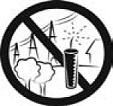 |
CHOOSE a wide, clear site away from all obstacles. Refer to the safety instructions on the fireworks label for minimum distances from spectators. |
CHOISIR un emplacement spacieux, bien dégagé et loin de tout obstacle. Consulter les consignes de sécurité sur l’étiquette des pièces pyrotechniques pour connaître les distances minimales entre les pièces et les spectateurs. |
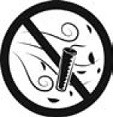 |
DO NOT FIRE IN WINDY CONDITIONS. |
NE PAS METTRE À FEU LES PIÈCES PYROTECHNIQUES PAR TEMPS VENTEUX. |
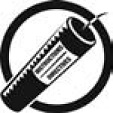 |
READ all instructions on the fireworks. PLAN the order of firing before you begin. |
LIRE toutes les instructions sur les pièces pyrotechniques. DÉTERMINER l’ordre de mise à feu avant de débuter. |
 |
USE A GOOD FIRING BASE such as a pail filled with earth or sand. |
UTILISER UNE BONNE BASE DE MISE À FEU, tel un seau, remplie de terre ou de sable. |
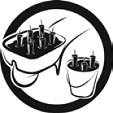 |
BURY fireworks that do not have a base HALFWAY in a container of earth or sand (such as a pail, box or wheelbarrow) unless the label on the firework indicates otherwise. Set them at a 10-degree angle, pointing away from people. |
ENFOUIR À MOITIÉ les pièces pyrotechniques qui ne possèdent pas de base dans un contenant (par exemple, un seau, une boîte ou une brouette) renfermant du sable ou de la terre, sauf indication contraire sur l’étiquette. Les installer à un angle de 10 degrés et les pointer en direction opposée des spectateurs. |
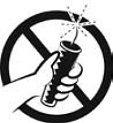 |
NEVER try to light a firework or hold a lit firework in your hand unless the instructions of the person who obtained its authorization indicate that they are designed to be hand-held. |
NE JAMAIS tenir dans la main des pièces pyrotechniques qui sont allumées ou que vous tentez d’allumer, sauf si les instructions de la personne qui a obtenu l’autorisation des pièces indiquent qu’elles sont conçues pour être tenues dans la main. |
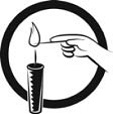 |
LIGHT CAREFULLY: Always light the fuse at its tip. |
ALLUMER PRUDEMMENT : toujours allumer la mèche à l’extrémité. |
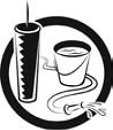 |
KEEP WATER NEARBY: Dispose of used fireworks (including debris) in a pail of water. |
GARDER DE L’EAU À PORTÉE DE LA MAIN : mettre les pièces pyrotechniques utilisées et les débris dans un seau d’eau. |
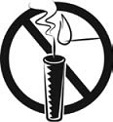 |
WAIT at least 30 minutes before approaching a firework that did not go off. NEVER try to RELIGHT a firework that did not go off. NEVER try to fix a firework that is defective. |
ATTENDRE au moins 30 minutes avant de s’approcher d’une pièce pyrotechnique dont la mise à feu n’a pas fonctionné. NE JAMAIS tenter de RALLUMER une pièce pyrotechnique dont la mise à feu n’a pas fonctionné. NE JAMAIS tenter de réparer une pièce pyrotechnique qui est défectueuse. |
 |
KEEP fireworks in a cool, dry, ventilated place, out of the reach of children. |
CONSERVER les pièces pyrotechniques dans un endroit frais, sec, aéré et hors de la portée des enfants. |
 |
IT IS RECOMMENDED that safety glasses be worn. |
IL EST RECOMMANDÉ de porter des lunettes de sécurité. |
32 Subsection 384(1) of the Regulations is replaced by the following:
Instructions
384 (1) A user must, when using special effect pyrotechnics, follow the instructions of the person who obtained their authorization.
33 Subsection 404(1) of the Regulations is replaced by the following:
Danger zone
404 (1) A danger zone must be established, taking into account the properties of the special effect pyrotechnics to be used, how they will be positioned, the instructions of the person who obtained their authorization, the weather conditions if the pyrotechnic event is to be held outdoors and the likelihood of harm to people or property resulting from the use of the pyrotechnics.
34 Subsection 406(1) of the Regulations is replaced by the following:
Instructions
406 (1) When setting up and firing the special effect pyrotechnics, the instructions of the person who obtained their authorization must be followed.
35 Subsection 434(5) of the Regulations is replaced by the following:
Handling
(5) Only a person who holds a fireworks operator certificate (display assistant), fireworks operator certificate (display supervisor), fireworks operator certificate (display supervisor with endorsement) or fireworks operator certificate (display visitor) may handle fireworks in the danger zone or fallout zone.
No smoking
(6) Smoking must be prohibited in the danger zone.
36 The English version of subsection 437(6) of the Regulations is replaced by the following:
Access
(6) After the display, only people designated to do a search by the display supervisor in charge may enter or be in the fallout zone until the display supervisor in charge declares the zone to be free of explosives.
37 The Regulations are amended by replacing “power device cartridges” with “blank cartridges for tools”, with any necessary modifications, in the following provisions:
- (a) paragraph 4(10)(c);
- (b) subparagraph 36(2)(d)(ii);
- (c) section 225;
- (d) the definitions distributor, licence, retailer and user in subsection 226(1) and the portion of subsection 226 before paragraph (a);
- (e) sections 227 and 228;
- (f) subsections 229(1) and (2);
- (g) section 230;
- (h) subsection 231(1) and the portion of subsection 231(2) before paragraph (a);
- (i) sections 232 to 236; and
- (j) subsection 237(1) and the portion of subsection 237(2) before paragraph (a).
38 The Regulations are amended by replacing “Minister of Natural Resources” with “Minister” in the following provisions:
- (a) the portion of section 12 before paragraph (a);
- (b) the portion of subsection 41(1) before paragraph (a);
- (c) section 42;
- (d) the definition secure storage site in subsection 44(1);
- (e) subsection 63(2);
- (f) subsection 94(2);
- (g) the definition manufacturing certificate in section 106;
- (h) subsection 147(2);
- (i) section 164;
- (j) subsections 169(1) and (2);
- (k) section 171;
- (l) subsection 173(4);
- (m) the definition approval letter in subsection 175(1);
- (n) subsection 177(1);
- (o) subsection 182(2);
- (p) subsection 183(1);
- (q) paragraph 191(3)(b), subsection (4), the portion of subsection (9) before paragraph (a) and paragraph (10)(b);
- (r) subsection 192(2) and paragraph (3)(b);
- (s) subsection 196(9);
- (t) subsection 201(2);
- (u) the definition licence in section 213;
- (v) paragraph 375(2)(b);
- (w) section 381;
- (x) the portion of section 386 before paragraph (a);
- (y) subsection 387(1);
- (z) paragraph 388(1)(d);
- (z.1) the portion of section 421 before paragraph (a);
- (z.2) subsection 422(1) and paragraph (3)(a);
- (z.3) paragraph 423(1)(d);
- (z.4) section 443; and
- (z.5) subsection 498(1).
39 The Regulations are amended by replacing “trade name” with “*product name” in the following provisions:
- (a) paragraph 30(b);
- (b) paragraph 41(1)(b);
- (c) paragraph 46(1)(c);
- (d) paragraphs 47(2)(c) and (7)(c);
- (e) paragraph 48(c);
- (f) paragraph 49(2)(c);
- (g) paragraphs 50(c) and (d);
- (h) paragraph 51(1)(a) and (3)(c);
- (i) subparagraph 60(5)(a)(i);
- (j) paragraph 74(1)(c);
- (k) paragraph 90(1)(a);
- (l) paragraph 117(1)(a);
- (m) paragraph 127(a);
- (n) paragraphs 209(c) and (d);
- (o) paragraphs 219(c) and (d);
- (p) paragraphs 250(c) and (d);
- (q) paragraphs 261(c) and (d);
- (r) paragraphs 295(c) and (d);
- (s) paragraphs 328(c) to (e);
- (t) paragraph 345(d);
- (u) paragraphs 353(c) and (d);
- (v) paragraphs 371(c) and (d);
- (w) paragraph 403(1)(c);
- (x) paragraphs 409(d) and (e);
- (y) paragraphs 420(d) and (e);
- (z) paragraphs 432(1)(d) and (e);
- (z.1) paragraphs 439(d) and (e);
- (z.2) paragraph 461(1)(b);
- (z.3) paragraph 475(1)(e); and
- (z.4) paragraph 492(1)(e).
40 The Regulations are amended by replacing “Quantity Distance Principles — User’s Manual, 1995, published by the Explosives Regulatory Division, Department of Natural Resources, with “National Standard of Canada Standard CAN/BNQ 2910–510/2015 entitled Explosives — Quantity Distances as amended from time to time”, in the following provisions:
- (a) paragraph 60(6)(f);
- (b) paragraph 145(3)(d); and
- (c) subsection 147(3).
41 The Regulations are amended by replacing “Storage Standards for Industrial Explosives, May 2001, published by the Explosives Regulatory Division, Department of Natural Resources” with “National Standard of Canada Standard CAN/BNQ 2910–500/2015 entitled Explosives — Magazines for Industrial Explosives, as amended from time to time” in the following provisions:
- (a) subparagraph 145(3)(f)(ii); and
- (b) subparagraph 162(1)(h)(iii).
42 Paragraph 162(2)(c) of the English version of the Regulations is amended by replacing “Quantity Distance Principles — User’s Manual, 1995, published by the Explosives Regulatory Division, Department of Natural Resources” with “National Standard of Canada Standard CAN/BNQ 2910–510/2015 entitled Explosives — Quantity Distances, as amended from time to time”.
43 Paragraph 162(2)(c) of the French version of the Regulations is amended by replacing “le document intitulé Principes de quantités de sécurité — Manuel de l’utilisateur, publié en 1995 par la Division de la réglementation des explosifs du ministère de Ressources naturelles” with “ la norme nationale du Canada CAN/BNQ 2910–510/2015 intitulée Explosifs — Distances par rapport à la quantité d’explosifs, avec ses modifications successives”.
44 The French version of the Regulations is amended by replacing “ministre des Ressources naturelles” with “ministre” in the following provisions:
- (a) subsections 169(4) and (5);
- (b) the portion of subsection 177(4) before paragraph (a);
- (c) the portion of subsection 183(4) before paragraph (a);
- (d) paragraph 422(3)(b); and
- (e) subsection 498(2).
45 The French version of the Regulations is amended by replacing “d’une licence” with “d’une licence, d’un permis ou d’un certificat” in the following provisions:
- (a) subsection 176(2); and
- (b) subsection 178(1).
46 The English version of the Regulations is amended by replacing “power device cartridges” with “blank cartridges for tools” in the following provisions:
- (a) paragraph 231(2)(f); and
- (b) paragraph 237(2)(f).
Coming into Force
47 These Regulations come into force on the day on which they are registered.
REGULATORY IMPACT ANALYSIS STATEMENT
(This statement is not part of the Regulations.)
Issues
Since 1995, explosives licences, permits, and certificates have been issued to businesses based on their compliance with two key standards: the 1995 Quantity Distance Principles — User’s Manual and the Storage Standards for Industrial Explosives, May 2001. These standards are what applicants require as reference documents to obtain a licence, permit or certificate.
Both standards were updated in 2015 to reflect already existing industry best practices for the safety and security of explosives storage. The Explosives Regulations, 2013, (the Regulations) are being updated to reference these two new standards.
At the same time, Natural Resources Canada (NRCan) is making a few minor, technical changes to the Regulations based on feedback received from stakeholders during the process of implementing the Regulations.
Background
Canada’s Explosives Act and Regulations control the manufacture, testing, acquisition, possession, sale, storage, transportation, importation and exportation of explosives and the use of fireworks. The term “explosive” covers a wide variety of products, including blasting explosives used for mining and construction, fireworks, small arms cartridges and many other specialized items. In 2013, Natural Resources Canada fundamentally revised the Explosives Regulations, C.R.C., c. 599 to reflect modern technologies and practices in the explosives industry, and to address provisions not in force of the Public Safety Act, 2002.
These regulatory changes (developed over a 10-year period) were made under amendments to the Explosives Act introduced by the Public Safety Act, 2002, which provided authorities for strengthened controls and provisions for import/export/in-transit of explosives, restricted components and security screening of persons having access to high hazard explosives. The Regulations came into force on February 1, 2014, with some provisions entering into force on February 1, 2015, and February 1, 2016.
The amended Regulations reflect modern practices in the explosives industry; removed duplications such as the elimination of regulatory requirements related to transport that are now covered by Transport Canada’s Transportation of Dangerous Goods Regulations; reduced unnecessary administrative burden on industry; and strengthened controls for known security gaps/risks. However, there are a number of minor regulatory amendments that are outstanding and need to be addressed, namely it is necessary to incorporate new versions of the two standards that are referenced in the Regulations.
The Quantity Distance Principles — User’s Manual sets out required minimum distances from explosives sites and vulnerable places defined as any building where people live, work or assemble in addition to public roads, railways, pipelines and energy transmission lines. Incorporating the new standard into the Regulations will ensure that appropriate minimum safety distances are observed in order to minimize injuries and damage to property in the event of accidental initiation of explosives.
The Storage Standards for Industrial Explosives, May 2001, which identifies minimum safety requirements for construction design for magazines (i.e. how the walls are constructed, how the door is secured) was found to have design flaws or deficiencies, which posed a risk to manufacturers and vendors in private industry. A new standard has been developed for well-ventilated magazines so that they are resistant to theft, weather and fire. For example, the new standard incorporates the use of non-sparking materials in order to minimize the likelihood of an accidental initiation. The new standard also incorporates design features, such as robust walls and doors to deter theft and minimize projectiles in the event of an accidental explosion.
Changes to the Quantity Distance Principles — User’s Manual and Storage Standards for Industrial Explosives, May 2001 already conform with industry best practices.
Objectives
With the Regulations now in force, NRCan is proceeding with a series of regulatory amendments, which
- update references in the Regulations to both standards to reflect current industry best practices. An updated Quantity Distance Principles — User’s Manual is incorporated to guide stakeholders who take part in planning the location of explosives storage or explosives manufacturing facilities; and an updated Storage Standards for Industrial Explosives, May 2001 is incorporated to provide clarity to the explosives industry on where to store and keep explosives;
- address comments and observations received from industry stakeholders during the initial implementation of the Regulations; and,
- correct minor errors (missed during the drafting of the Regulations).
Description
Regulatory amendments
1. Incorporated standards
The standards (Quantity Distance Principles — User’s Manual and Storage Standards for Industrial Explosives, May 2001) are used by applicants applying for a factory or magazine licence in the blasting, mining, quarrying, construction, oil extraction and fireworks industries and sectors. Updating the standards was required, as new research and/or incidents or accidents demonstrated that the existing standards could be improved to provide better safety and security of explosives. Stakeholders were fully involved with the development of both standards in order to ensure that they were clear, comprehensive and that they facilitated regulatory compliance.
NRCan’s Explosives Safety and Security Branch worked with the Bureau de normalisation du Quebec (BNQ), through a Standards Council of Canada (SCC) process, to update and issue the two standards regarding the storage of high-hazard industrial explosives and quantity distance principles.
The Quantity Distance Principles — User’s Manual was updated based on new scientific knowledge of modern explosives. It prescribes minimum safety distances to minimize damage in case of an accidental initiation. Storage distances were modified to reflect upcoming changes to North Atlantic Treaty Organization (NATO) tables (i.e. calculations of how far explosives must be stored from neighboring infrastructure to minimize the risk associated with an accidental explosion). Concepts such as containment barricades (i.e. physical barriers to limit the damage associated with an accidental explosion); exposed site (i.e. a site that would be hit by debris in the event of an explosion); and picking areas (i.e. areas for gathering explosives for packaging) are now defined in the new standard.
The Storage Standards for Industrial Explosives, May 2001 was updated to better define design options that were proven to be more efficient at preventing theft than magazine types previously on the market. Specifically, NRCan worked with stakeholders to address a shortcoming with the Storage Standards for Industrial Explosives, May 2001 by developing an enhanced, secured sliding and/or double door to suit the larger openings, which accommodates traditional mobile materials-handling equipment used by explosives manufacturers or vendors. The new door design contributed to the hardening of the magazine container against criminals using modern power tools. This raised and improved security against attempted theft, thus closing a regulatory gap and permitting additional response time by authorities.
2. Observations and experiences of stakeholders with the Regulations to date
During the implementation of the Regulations, some comments and observations were received from stakeholders on their experience with the Regulations to date. The regulatory amendments will address these comments and provide more flexibility to regulated entities without impacting safety or security. Examples of changes based on comments and observations from stakeholders include the following:
- Clarifying storage requirements for magazine licences: Part 6 of the Regulations imposes onto a magazine licence holder, the obligation to obtain keys from a certified locksmith for security reasons. However, this requirement was not intended for licence holders storing low-hazard and low-risk explosives. The amendment clarifies that this requirement is applicable to licence holders that are storing high-hazard explosive types: E (blasting); I (initiation systems); and D (defence) explosives.
- Import permit exemptions for low hazard rocket motors: As a result of the previous Canada Gazette consultation process for the Regulations, the section on Model and High-Power Rocket Motors was amended to allow sales of 80 newton-seconds rocket motors to a user who is at least 12 years old, rather than limiting them to 40 newton-seconds. However, an omission was made at the time, as 80 newton-seconds rocket motors should also have been exempted from the import permit requirement if a quantity not exceeding 6 rocket motors is imported for personal use, since sales of these types of rocket motors present a low level of risk. The regulatory change will remove the requirement for an import permit.
- Labelling flexibility: Parts 4 and 5 of the Regulations require importers or manufacturers of explosives to have a printed label providing the date of manufacture of an explosive, and if the manufacturer carries out manufacturing operations in shifts, the shift during which it was manufactured. This was required for traceability in the event of a loss or theft of explosives. The requirement is being changed to “the date of its manufacture and shift, if any, or lot number”. A lot number provides the same type of traceability and is therefore considered to be an acceptable alternative.
- Elimination of redundant labelling information: Similarly, Parts 4 and 5 of the Regulations require the printing of full classification and trade name on a package. An industry association commented that this requirement was providing minimal safety benefits as there would be triplicate information related to intrinsic hazards of the multi-purpose full classification (type, hazard category and UN number) on the package. Since the requirement for full classification on explosives packaging was never enforced (as it was determined to be an unnecessary requirement), removing the requirement through this amendment provides regulatory clarity to stakeholders.
Specifically, the requirement to print the full classification on packages is eliminated for seven of the nine classes of explosives. Two classes (type F - fireworks and type S - special purpose explosives) still require that the type classification be printed on the package for safety reasons to distinguish between explosives that are subject to sales restrictions and those that are not.
- Eliminating duplicate reporting requirements: This amendment eliminates the need for importers of explosives to submit Importer’s Transaction Report F04-02 to NRCan in cases where they already provide reports by electronic means to the Canada Border Services Agency (CBSA) on the importation of explosives. Information contained within this form, such as name, address, permit number, quantity, country of origin etc. of the importer is already available to NRCan through the CBSA Single Window Initiative (SWI). Through the SWI, importers will be able to provide all required import information electronically to the CBSA. In turn, the CBSA will transmit the appropriate information to NRCan. NRCan will assess the information and provide any decisions as required. This will streamline and simplify the import process and will significantly reduce the burden on the business community.
3. Typographical Errors
- The proposal will correct typographical errors in the Regulations, some technical errors in the coming into force provisions as well as errors in certain terminology.
“One-for-One” Rule
The proposal is an “OUT” under the Rule as it would result in an annualized savings of $2,104 to industry through the elimination of duplicate reporting requirements. Currently, explosives importers are required to report the same information to both the CBSA and NRCan. With the changes, NRCan will no longer require importers to submit Importer’s Transaction Report F04-02 and instead use the data reported to CBSA if the importer is submitting the information electronically, so that the importer does not have to report twice. The savings are calculated based on an estimate of 20 minutes required to fill out the report by a clerk, multiplied by the average of 350 import permits issued by NRCan per year. It was assumed there are 350 businesses each making one application per year. Of these 350 businesses, 175 were identified as small businesses. The estimated cost savings calculations have been confirmed by a sampling of small, medium and large businesses.
Small business lens
The small business lens does not apply to the proposal, as it does not impose any costs on small business. Some small businesses were part of the standards consultation process. In addition, the reduction of duplicate reporting requirements will also benefit approximately 175 small businesses.
Consultation
The coming into force of the Regulations, which was developed through close consultation with various industry stakeholder groups over a number of years, had strong support and was eagerly anticipated. Since the Regulations were implemented, through continued consultations with our industry stakeholders, NRCan has received numerous positive comments on the regulatory compliance efficiency and the reduction of burden that the regulatory amendments delivered to industry. The same industry stakeholder groups were also actively involved with updating the Quantity Distance Principles — User’s Manual and the Storage Standards for Industrial Explosives, May 2001, and they have provided concurrence for their issuance as national standards. In addition, the other minor amendments were driven by stakeholders as a result of comments made during the implementation of the Regulations. Consultations with stakeholder groups take place on an ongoing basis, as NRCan representatives attend annual meetings of the explosives associations.
Rationale
While the changes are predominantly administrative in nature, Canadians, in general, will be safer due to:
- new scientific evidence and analyses reflected in the new Explosives — Magazines for Industrial Explosives standard for more secure magazines, elimination of magazine design features that were proven susceptible to thefts (e.g. elimination of type 6 magazines that were broken into repeatedly in the past); and
- the new Explosives — Quantity Distances standard, which provide guidance for the distances at which explosives must be stored away from the public. For example, the behavior of consumer fireworks is now better understood and minimum safety distances, depending on storage conditions, were adjusted in the Quantity Distance Principles — User’s Manual. Consumer fireworks may behave innocuously if they are stored in small quantities; however some types may react violently if present in larger amounts in confined spaces.
There are benefits to stakeholders, as the new standards, which were updated through a Standards Council of Canada process, will be made available free of charge on the NRCan Web site. There is no cost to the Government, as both standards were previously updated and their implementation is based on amendments to the Regulations to conduct licensing activities.
There is no cost to businesses as both updated standards reflect best practices already adopted by the industry.
Implementation, enforcement and service standards
Current enforcement and service standards would remain in force. For enforcement, licence holders are inspected at intervals determined by their risk profile (i.e. type of stored explosives, compliance history etc.). Service standards for explosives licence applications are available at: http://www.nrcan.gc.ca/explosives/acts-regulations/13840.
Contact
Jean-Luc Arpin
Director and Chief Inspector of Explosives
Explosives Regulatory Division
Minerals and Metals Sector (MMS)
Natural Resources Canada (NRCan)
Telephone: 343-292-8731
Cell phone: 613-355-1291
Email: jean-luc.arpin@canada.ca
- Footnote a
S.C. 2015, c. 3, s. 82 - Footnote b
R.S., c. E-17 - Footnote 1
SOR/2013-211